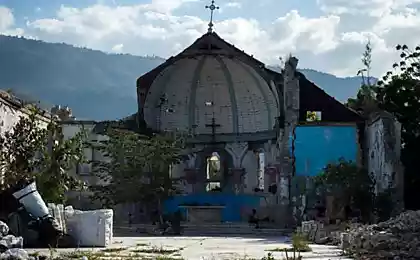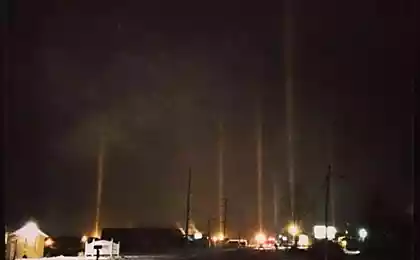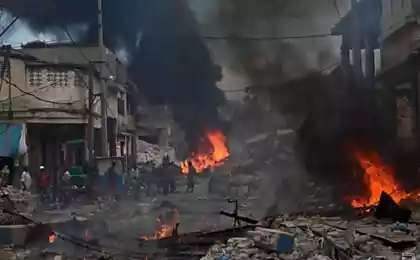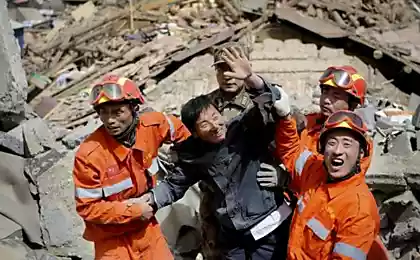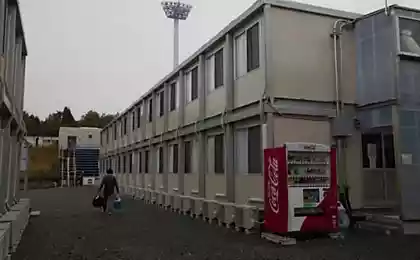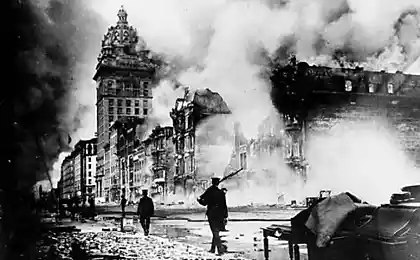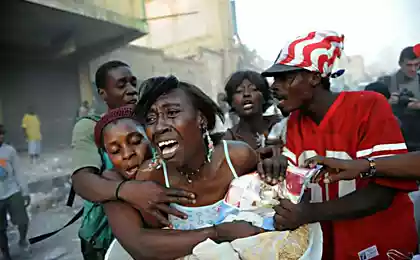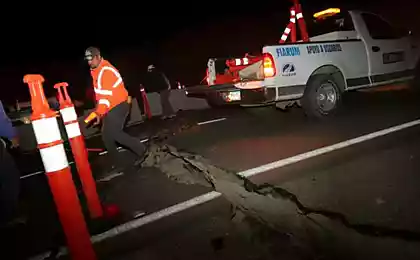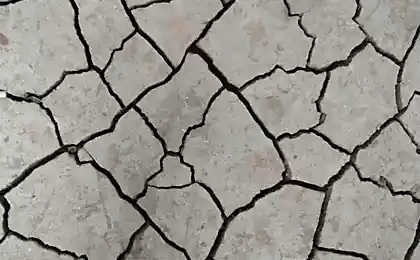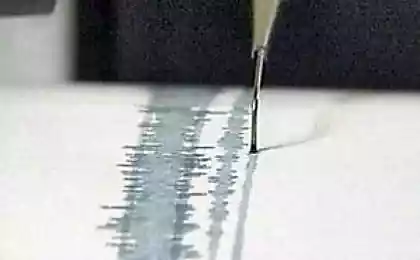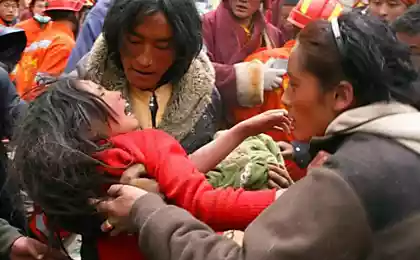2054
Haiti six months after the earthquake
When a disaster happens, the population of Port-au-Prince poured into the half-lit streets. Crumbling house turned into a deadly trap. In open areas, parks, golf courses have grown campgrounds. Corpses lay everywhere, covered with a cloth, cardboard, or overt at all. Most of the dead were taken away in garbage trucks, some burned, some being found in secluded places. The body was removed, but the wreckage of buildings (estimated at around 20 million. Cubic meters) - no. Blockages do most of the city impassable for vehicles. 300 machines working at their cleaning every day, but not yet cleared more than two percent of the total. Number of people living in tent camps, rose to 1, 6 million, but still built a small amount of new housing.
Most of the money out of 3, 1 billion dollars of humanitarian aid went to the arrangement of field hospitals, canvas for tents, bandages, food, plus salaries disaster liquidators and transportation. About 1, $ 3 billion spent by the liquidators of the United States. There are still millions of dollars, but some organizations, such as the American Red Cross, state that they are not going to throw money into crude, poorly managed projects. Aid workers say the financial aid to Haiti has helped prevent epidemics, floods and civil strife on the island, and also managed to provide the population with basic food and basic necessities. Supply with food is satisfactory, and medicine, thanks to the influx of foreign doctors and equipment, is now even better than it was on the island before the disaster.
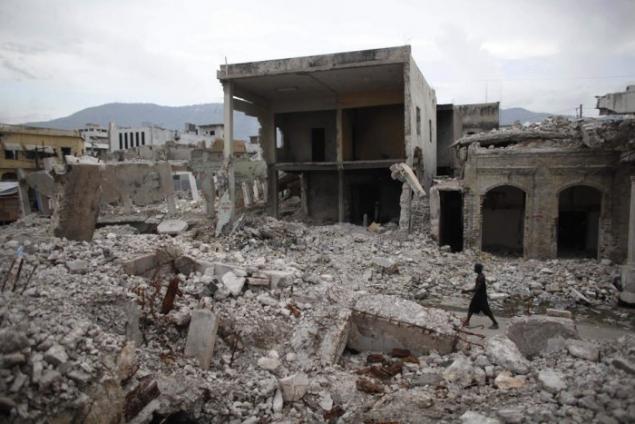
Most Haitians how to live without electricity or running water before the earthquake, and live.
Police and UN peacekeeping force to maintain order in the country. After the disaster has increased the level of crime in the camps thrive robberies and attacks, especially on women and girls. However, the level of violence is far reaches of the scope that was 6 years ago, before the island landed UN forces.
Thus, survival and meeting the most urgent needs of the residents are provided, but no more. Haitian President Rene Preval is working in a temporary building near the ruins of the presidential palace. Houses and shops are in ruins. Distributed over 665,700 oilcloth fabrics for awnings and 97,000 tents, but many of them are already worn out. Authorities planned to build 125,000 temporary houses - the amount that is still not enough for all the homeless; but built only 3 722. Another four times as many homes awaiting construction. Supplies all still a little arrives at a port, but not enough space to build a new - all busy ruins. Thus, the rehabilitation of infrastructure mainly as there is only a draft.
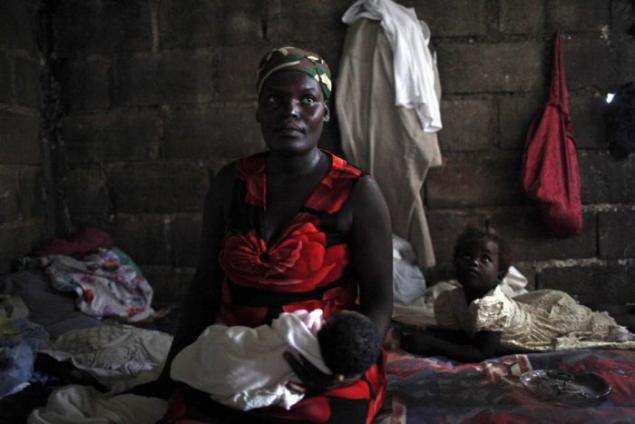
Menmen Villas, a spontaneous settler in a slum near the camp Corail-Cesselesse north of Port-au-Prince sits in his hut. She is one of thousands of people left homeless by the earthquake, which came on the vacant strip of land between the mountains and the sea, preferring its overcrowded camps in the city. At this point, the authorities plan to build a "new Haiti." Restoration of the city is still virtually moved the ball rolling for the 6 months since the moment when the 7-magnitude earthquake leveled much of the capital and claimed thousands of lives. (AP Photo / Alexandre Meneghini)
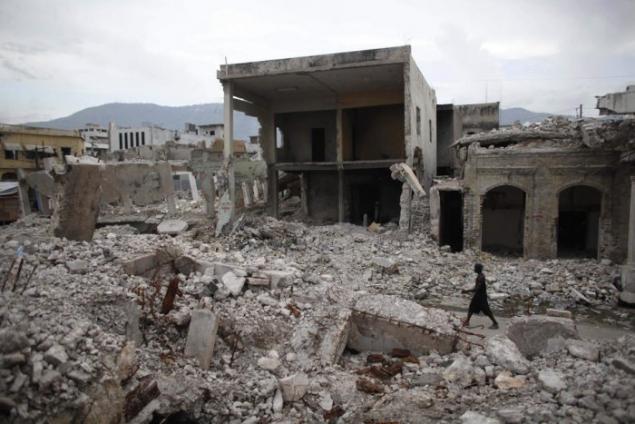
The man goes in the ruins and dilapidated buildings in downtown Port-au-Prince after 6 months after the devastating earthquake of 12 January. In the city center was located a large part of the industry and commerce of the island. Now it destroyed about 80% of the buildings. A draft of the full reconstruction of the area, for which the required $ 100 million. But the Haitian government does not know where to get these funds. (AP Photo / Alexandre Meneghini)

Camp «Corail-Cesselesse» for the homeless on the outskirts of Port-au-Prince. Women lined up to add their names to the list of recruitment. Next to this camp stretched arisen more recently, after the earthquake slums, squeezed between the sea and barren cliffs to the north of Port-au-Prince. (AP Photo / Alexandre Meneghini)
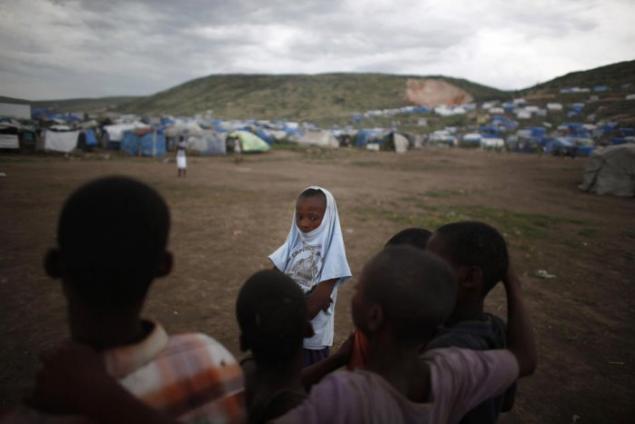
The boys gathered in the camp «Canahan-2" for the homeless on the outskirts of Port-au-Prince. Most Haitians did not have as running water or electricity in their homes before the disaster, and do not have now. (AP Photo / Alexandre Meneghini)
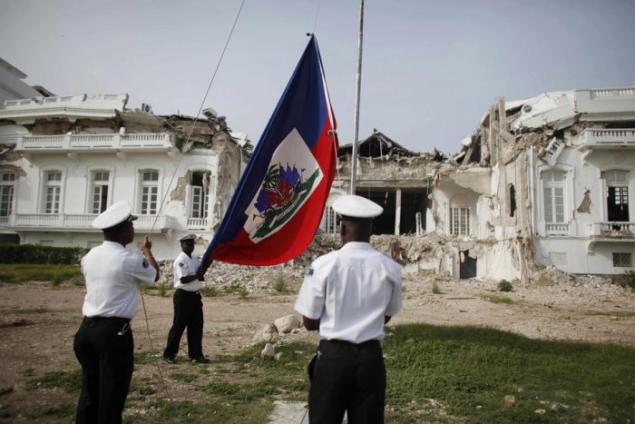
Police raise the flag of Haiti before the earthquake destroyed the National Palace. On paper, there are several major projects of reconstruction of government buildings (15 of 17 destroyed), but no official decision has been made, and the future of these structures remains unclear. (AP Photo / Alexandre Meneghini)

People lined up to get in the tent camp "Canahan-2", where earthquake victims live. (AP Photo / Alexandre Meneghini)
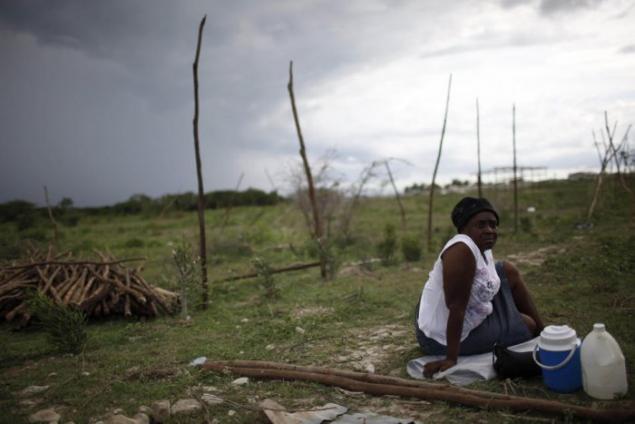
45-year-old Bonnie Jenis left without homes as a result of the earthquake, the village of rest, while her family members (not visible in the photo) built a hut near the campground. (AP Photo / Alexandre Meneghini)

30-year-old Louis Antilis remaining homeless by the earthquake, stands in front of his hut near the campground «Corail-Cesselesse». (AP Photo / Alexandre Meneghini)
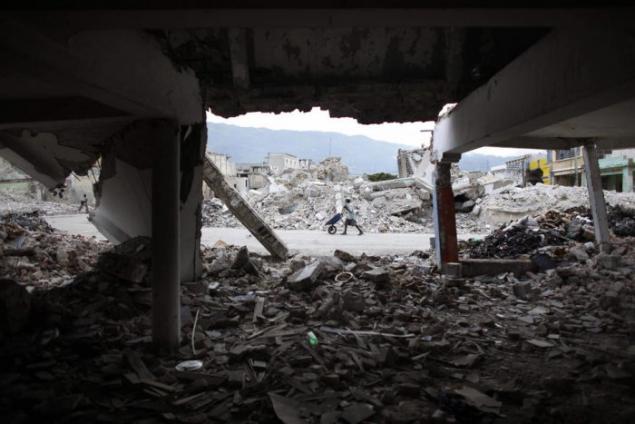
Man pulls a wheelbarrow with a variety of goods in downtown Port-au-Prince. In the markets you can find anything from antique furniture to tires Hankook. (AP Photo / Alexandre Meneghini)
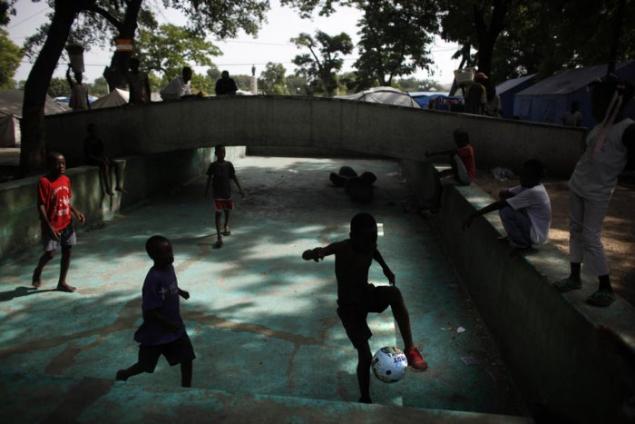
Children playing in the dry fountain near the camp for the homeless in Port-au-Prince. (AP Photo / Alexandre Meneghini)
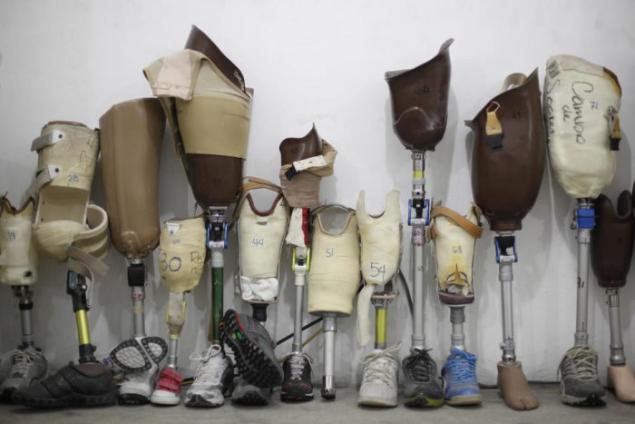
Prosthetic legs belonging earthquake crippled people standing against the wall in a rehabilitation center in Port-au-Prince. Handicap «Handicap International» estimates the number of amputations as a result of the earthquake in the area between two and four thousand. Many people who have lost limbs, are still in need of prosthetics. (AP Photo / Alexandre Meneghini)

A woman walks past the night burning piles of garbage in the center of Port-au-Prince. Sometimes it seems that all this does not happen in the world, and in any browser-based online game. But unfortunately it is not. (AP Photo / Alexandre Meneghini)
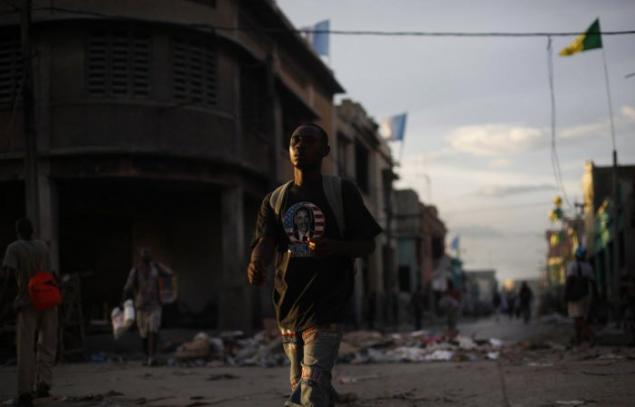
A man goes among ruined buildings in downtown Port-au-Prince. (AP Photo / Alexandre Meneghini)
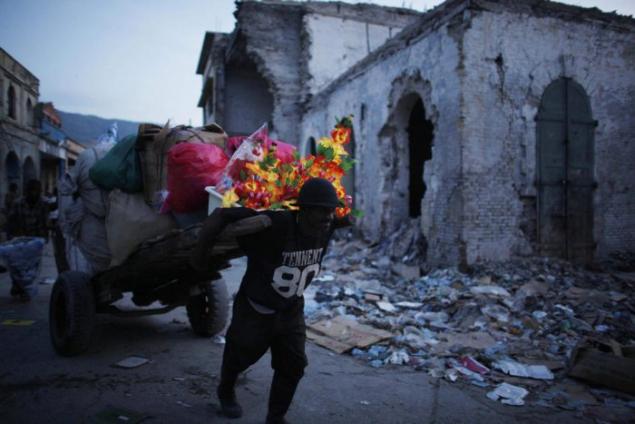
Man pulls a wheelbarrow with a variety of goods in downtown Port-au-Prince. (AP Photo / Alexandre Meneghini)
Most of the money out of 3, 1 billion dollars of humanitarian aid went to the arrangement of field hospitals, canvas for tents, bandages, food, plus salaries disaster liquidators and transportation. About 1, $ 3 billion spent by the liquidators of the United States. There are still millions of dollars, but some organizations, such as the American Red Cross, state that they are not going to throw money into crude, poorly managed projects. Aid workers say the financial aid to Haiti has helped prevent epidemics, floods and civil strife on the island, and also managed to provide the population with basic food and basic necessities. Supply with food is satisfactory, and medicine, thanks to the influx of foreign doctors and equipment, is now even better than it was on the island before the disaster.

Most Haitians how to live without electricity or running water before the earthquake, and live.
Police and UN peacekeeping force to maintain order in the country. After the disaster has increased the level of crime in the camps thrive robberies and attacks, especially on women and girls. However, the level of violence is far reaches of the scope that was 6 years ago, before the island landed UN forces.
Thus, survival and meeting the most urgent needs of the residents are provided, but no more. Haitian President Rene Preval is working in a temporary building near the ruins of the presidential palace. Houses and shops are in ruins. Distributed over 665,700 oilcloth fabrics for awnings and 97,000 tents, but many of them are already worn out. Authorities planned to build 125,000 temporary houses - the amount that is still not enough for all the homeless; but built only 3 722. Another four times as many homes awaiting construction. Supplies all still a little arrives at a port, but not enough space to build a new - all busy ruins. Thus, the rehabilitation of infrastructure mainly as there is only a draft.

Menmen Villas, a spontaneous settler in a slum near the camp Corail-Cesselesse north of Port-au-Prince sits in his hut. She is one of thousands of people left homeless by the earthquake, which came on the vacant strip of land between the mountains and the sea, preferring its overcrowded camps in the city. At this point, the authorities plan to build a "new Haiti." Restoration of the city is still virtually moved the ball rolling for the 6 months since the moment when the 7-magnitude earthquake leveled much of the capital and claimed thousands of lives. (AP Photo / Alexandre Meneghini)

The man goes in the ruins and dilapidated buildings in downtown Port-au-Prince after 6 months after the devastating earthquake of 12 January. In the city center was located a large part of the industry and commerce of the island. Now it destroyed about 80% of the buildings. A draft of the full reconstruction of the area, for which the required $ 100 million. But the Haitian government does not know where to get these funds. (AP Photo / Alexandre Meneghini)

Camp «Corail-Cesselesse» for the homeless on the outskirts of Port-au-Prince. Women lined up to add their names to the list of recruitment. Next to this camp stretched arisen more recently, after the earthquake slums, squeezed between the sea and barren cliffs to the north of Port-au-Prince. (AP Photo / Alexandre Meneghini)

The boys gathered in the camp «Canahan-2" for the homeless on the outskirts of Port-au-Prince. Most Haitians did not have as running water or electricity in their homes before the disaster, and do not have now. (AP Photo / Alexandre Meneghini)

Police raise the flag of Haiti before the earthquake destroyed the National Palace. On paper, there are several major projects of reconstruction of government buildings (15 of 17 destroyed), but no official decision has been made, and the future of these structures remains unclear. (AP Photo / Alexandre Meneghini)

People lined up to get in the tent camp "Canahan-2", where earthquake victims live. (AP Photo / Alexandre Meneghini)

45-year-old Bonnie Jenis left without homes as a result of the earthquake, the village of rest, while her family members (not visible in the photo) built a hut near the campground. (AP Photo / Alexandre Meneghini)

30-year-old Louis Antilis remaining homeless by the earthquake, stands in front of his hut near the campground «Corail-Cesselesse». (AP Photo / Alexandre Meneghini)

Man pulls a wheelbarrow with a variety of goods in downtown Port-au-Prince. In the markets you can find anything from antique furniture to tires Hankook. (AP Photo / Alexandre Meneghini)

Children playing in the dry fountain near the camp for the homeless in Port-au-Prince. (AP Photo / Alexandre Meneghini)

Prosthetic legs belonging earthquake crippled people standing against the wall in a rehabilitation center in Port-au-Prince. Handicap «Handicap International» estimates the number of amputations as a result of the earthquake in the area between two and four thousand. Many people who have lost limbs, are still in need of prosthetics. (AP Photo / Alexandre Meneghini)

A woman walks past the night burning piles of garbage in the center of Port-au-Prince. Sometimes it seems that all this does not happen in the world, and in any browser-based online game. But unfortunately it is not. (AP Photo / Alexandre Meneghini)

A man goes among ruined buildings in downtown Port-au-Prince. (AP Photo / Alexandre Meneghini)

Man pulls a wheelbarrow with a variety of goods in downtown Port-au-Prince. (AP Photo / Alexandre Meneghini)

